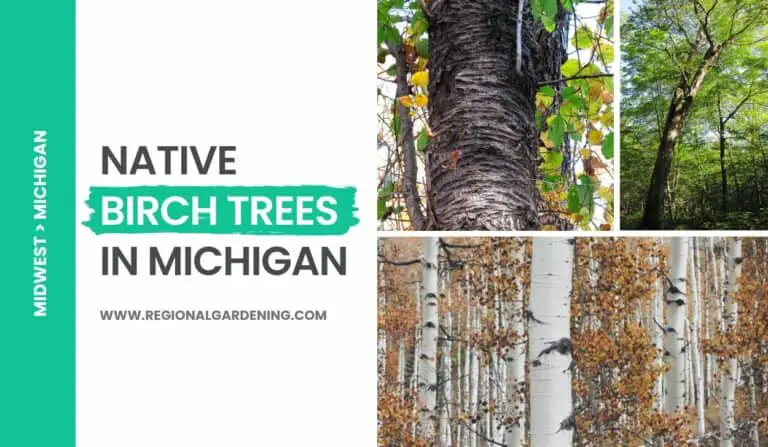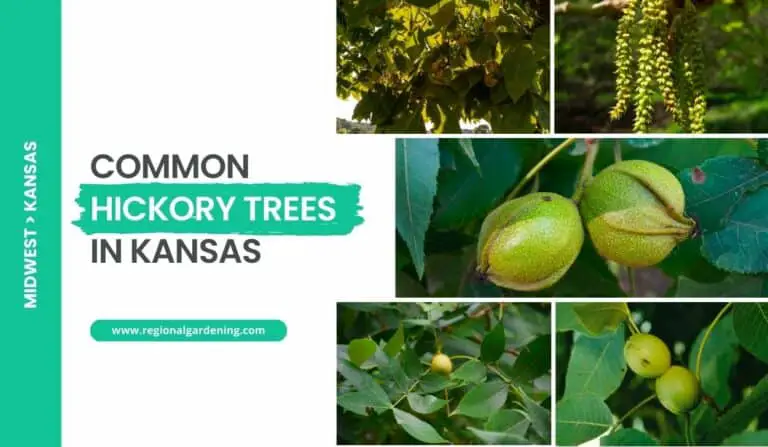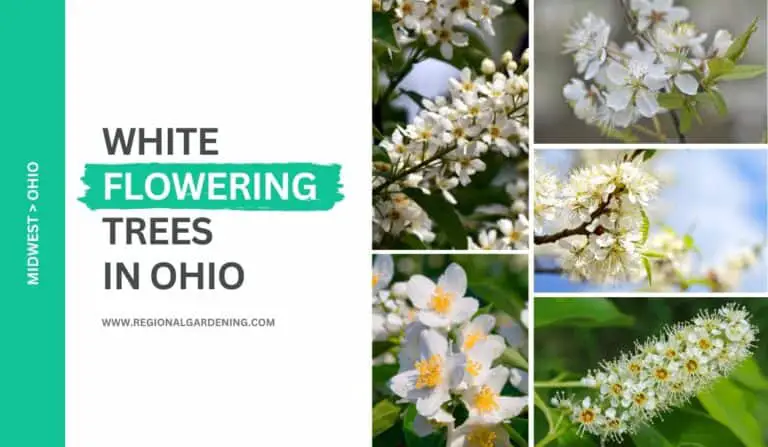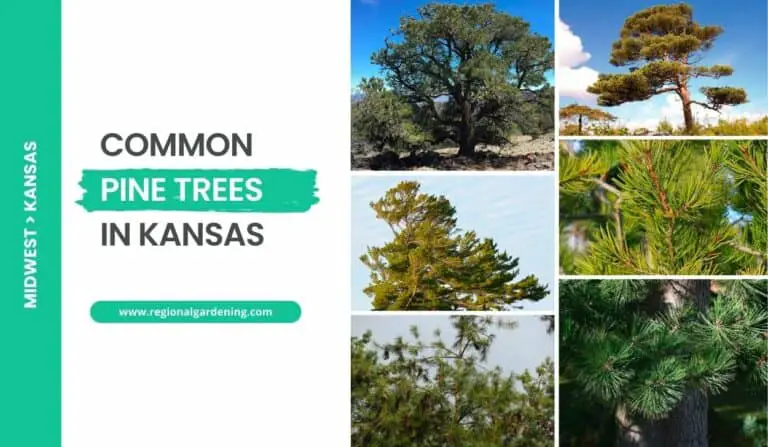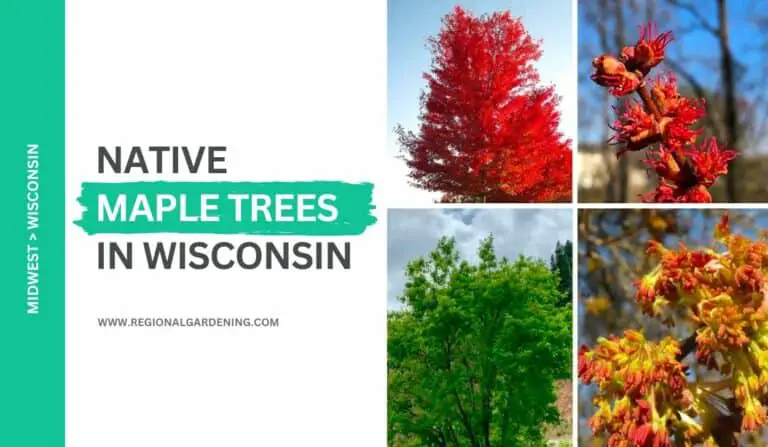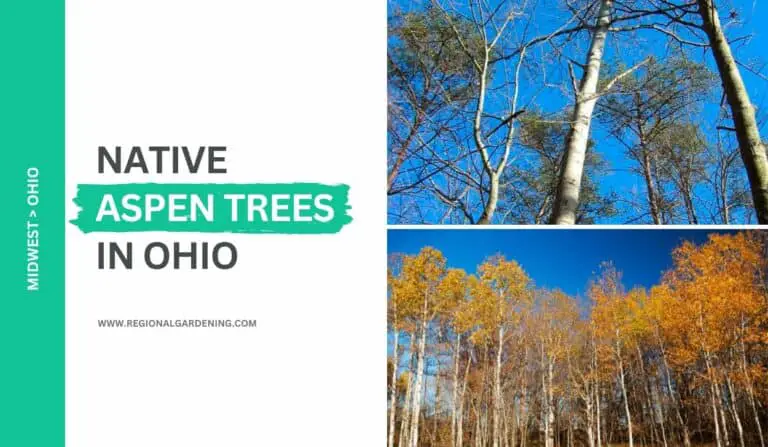9 Common Yellow Flowering Trees In Ohio (Pictures & Care Tips)

Each state has its own charm, but Ohio is renowned for its breathtaking natural beauty. The bright yellow flowers that bloom in the spring and summer are among the most breathtaking sights in the state.
You’re sure to see these yellow blooms whether you’re driving through the countryside or strolling through one of Ohio’s many parks. And, it is impossible to not be awed by the beauty of these flowers given their brilliant yellow color.
In this article, we’ll look at some of the most widespread yellow flowering trees in Ohio and discover more about their special traits and applications.
1. American Basswood
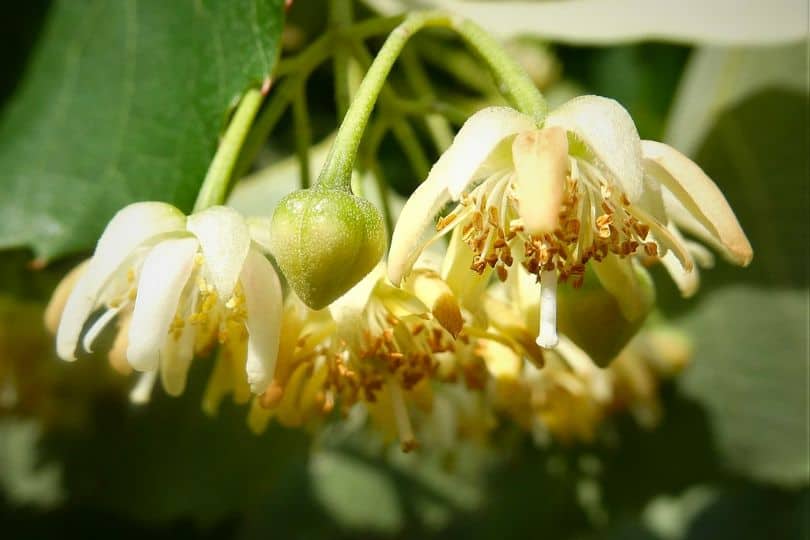
- Common Name: American Basswood
- Scientific Name: Tilia americana
- Mature Height: 50-70 feet
- Native/Non-Native: Native
- Flowers: Yellow flowers
- Uses: For carving and honey production
American Basswood trees are the most common yellow flowering trees in Ohio. It is a stately tree that can reach heights of 70 feet with a complete round crown. It features heart-shaped leaves that can grow to be up to 7 inches long, are dull green on top and lighter green underside, and have sharp-toothed borders.
When young, the bark is smooth and light gray, but it darkens with time, with long, narrow, flat-topped ridges splitting into a short block.
The tree bears fragrant, creamy yellow flowers that measure about 1-2 inches across. Because of their delicious nectar, these flowers are vital in bees’ production of high-quality honey.
The fruit of the American Basswood is nut-like, green, and about 1/4 inch in diameter when mature, becoming yellow. They have light brown hairs on their wings and hang in bunches from a 1-2 inch tall fruit stem.
The American Basswood tree is a native tree that can be found throughout the United States. It enjoys moist soils with some protection from the sun. Because of its smooth grain, the lightweight, soft wood of American Basswood is frequently used for carving.
Additionally, American Indians originally used the inner bark’s fibrous material to make mats, baskets, and rope.
2. Witch hazel
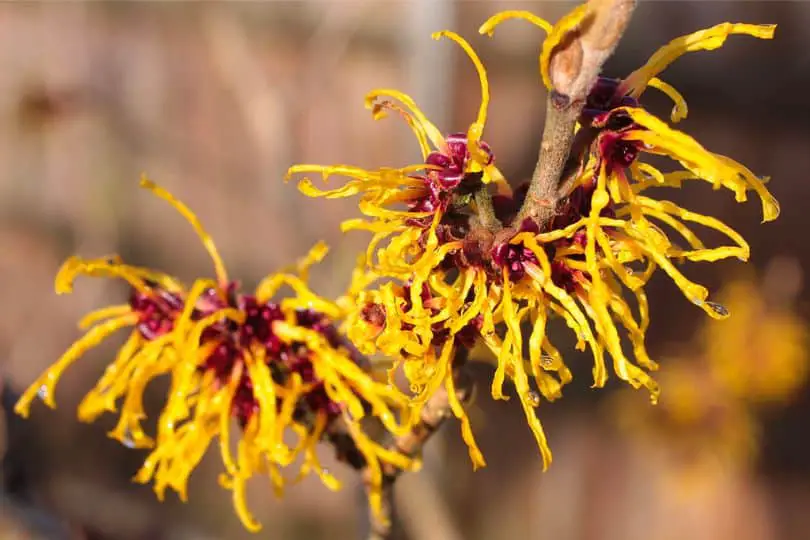
- Common Name: Witch-hazel
- Scientific Name: Hamamelis virginiana
- Mature Height: 20-30 feet
- Native/Non-Native: Native
- Flowers/Cones: Bright yellow flowers
- Uses: Medicinal use as an astringent
One of the shortest varieties among commonly found yellow flowering trees in Ohio, the witch-hazel is a tiny tree with a big open crown and numerous slender crooked trunks.
The leaves range in shape from oval to round, with a pointy or rounded tip, irregular wavy edges, and coarse teeth. The leaves have a dark green upper surface and a slightly paler lower surface. The bark is light brown, uniform, and scaly at times.
The vivid yellow flowers that witch-hazel produces in the autumn set it apart from other plants. The blooms have four long, thin, twisted petals and grow in three-petal clusters at the joint where a leaf joins to the twig.
The fruit is a green capsule that turns orange and rips open next autumn. The capsule is 34 to 1 inch in length and contains two little lustrous black seeds.
Witch-hazel blooms at a strange period, and its capsules linger on the tree for several years after the seeds have fallen to the ground. The name “Witch” in Witch-hazel is derived from the old English word “Wice,” which refers to a plant with bending branches. The name “Hazel” stems from the likeness of the leaves to the hazel bush (Corylus spp.).
Witch-hazel’s aromatic leaves, twigs, and bark have been employed as an astringent in therapeutic washes. They provide a variety of health benefits, including the treatment of inflammation, skin irritation, and minor cuts and bruises.
3. Tulip-tree
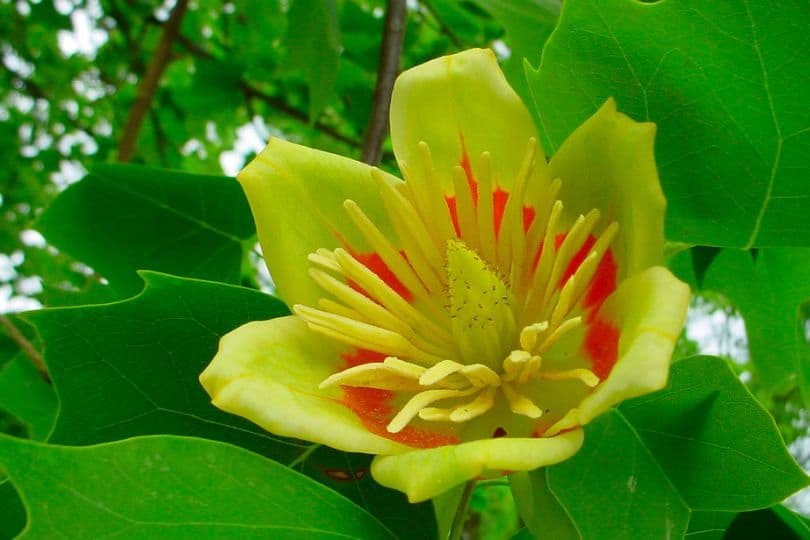
- Common Name: Tulip-tree
- Scientific Name: Liriodendron tulipifera
- Mature Height: 80-100ft
- Native/Non-Native: Native
- Flowers/Cones: Large showy tulip-shaped flowers
- Uses: Tonic from roots used for heart ailments
Tulip trees are among the tallest yellow flowering trees in Ohio forests, reaching heights of more than 150 feet usually and 200 feet occasionally.
The flowers of a Tulip tree might help you identify it. The flowers are enormous and gorgeous, with tulip-like shapes. They are roughly 1-2 inches long and yellow with orange bases. It receives its common name from the flowers that grow on it.
The leaves of the tulip tree are also intriguing. Their leaves are lobed and range in length from 3 to 6 inches. Some of the leaves are nearly square, but the majority have 4-6 pointed lobes. The leaves are bright green on top and lighter on the bottom.
If you ever get a chance to see the bark of a Tulip tree, you’ll notice that it’s severely wrinkled and gray. The bark on the trunk of the tree grows increasingly wrinkled as it ages.
Another interesting aspect about Tulip trees is that their fruit resembles a cone. The fruit turns a light brown color as it matures and grows upright on the branch. Inside the fruit are small winged nutlets that fall apart and release seeds in the autumn.
Tulip trees are found in damp soils along streams, ponds, and other wet regions in sunny settings. They are distributed throughout the eastern United States and can live for 100-150 years.
4. Cucumbertree
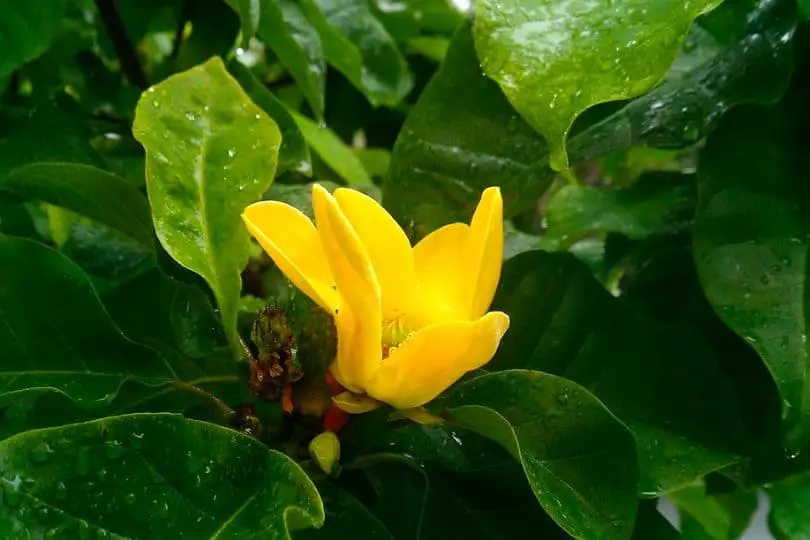
- Common Name: Cucumbertree
- Scientific Name: Magnolia acuminata
- Mature Height: 40-60 feet
- Native/Non-Native: Native
- Flowers/Cones: 6-petaled white-to-yellow flowers, cone-shaped fruit
- Uses: Ornamental, lumber, wildlife food source
Cucumbertree is a lovely medium-sized tree with a straight trunk and thin pointed crown that can reach heights of 40-60 feet. It has short, erect spreading branches with 5-10 inch long green oval leaves.
The leaves are alternately attached, pointy at the top and circular at the bottom, with a toothless wavy edge. The upper side of the leaves is green, while the lower surface is lighter and covered with fine soft hairs.
Cucumbertree’s bark is dark with small wrinkled rows. In the spring, it produces big 6-petaled white-to-yellow flowers that are 2-3 12 inches in diameter and grow solitary at the end of a branch. The tree produces cone-shaped fruit that is green while young but turns dark crimson as it matures. The fruit is around 1 12 – 2 12 inches long and is linked to a long fruit stalk at the end of a branch.
The cucumbertree’s fruit is unique in that it looks like unripened cucumbers. As a result, it receives its name from there. The flesh of the fruit turns juicy and sour-sweet as it ripens; it is edible but not usually consumed by people. The fruit is appreciated by a variety of birds and mammals, including deer, raccoons, and squirrels, who are drawn to the tree for food.
Cucumbertree is native to the eastern portion of the state and thrives in a wide range of soil conditions ranging from moist to dry, typically in moist valleys with moderate shade. These trees are one of the most common medium-sized yellow flowering trees in Ohio.
This species is the largest and most hardy of our native magnolias, with a lifespan of 125-150 years. The cucumbertree is frequently cut for lumber, and its wood is used to make furniture.
It is often planted as an ornamental tree since it grows quickly and looks beautiful in gardens. It takes approximately 25-30 years to mature and produces blooms and fruit every year, with substantial seed crops every 3-5 years.
5. Sassafras
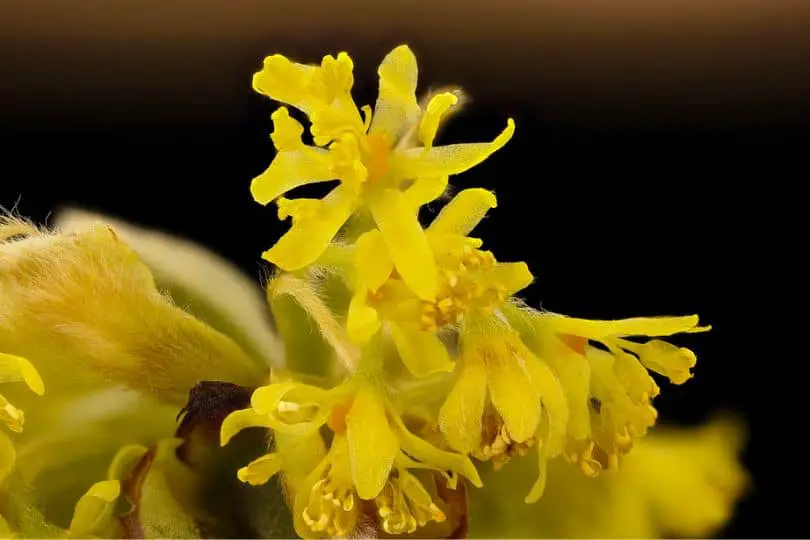
- Common Name: Sassafras
- Scientific Name: Sassafras albidum
- Mature Height: 30–60′ (9–18 m)
- Native/Non-Native: Native
- Flowers/Cones: Green-to-yellow flowers, blue-to-nearly-black fruit
The sassafras tree is a medium-sized tree with a crooked trunk and spreading branches. The tree has a flat, uneven crown with lobed or simple leaves.
These leaves are joined alternately and have one, two, or three lobes, with mitten-shaped 1-lobed leaves. Simple elliptical leaves appear alongside lobed leaves on the same tree. The glossy green leaves have a smooth toothed border, are paler below, and are frequently hairy.
The tree’s brown bark has become deeply furrowed with age. Sassafras flowers are green-to-yellow and 14″ (.6 cm) wide, growing in clusters on a 1-2″ (2.5-5 cm) long stalk. The tree’s fruit is blue-to-nearly-black and 12″ (1 cm) wide, with a 1″ (2.5 cm) tall fruit stalk with clusters of one seed.
Sassafras is a North American native that has been growing for more than 100-150 years. The tree thrives in both moist and dry soils, along forest borders, and in full to partial sun.
The crushed leaves and twigs of Sassafras have a spicy aroma, similar to other laurels. Historically, the tree’s shallow roots were used to extract sassafras oil for perfuming soap. The settlers also made tea from the bark and roots.
Sassafras was originally thought to have medical powers, however, a component in the plant has now been linked to cancer. As a result, it is no longer permitted as a food additive. Sassafras is an American Indian term for one of America’s first exports. It provides dense shelter and fruit for wildlife and is occasionally planted as an ornamental because of its fall colors and fruit. The tree’s wood is fragile and easily broken.
The cherries are the most popular of the Sassafras tree’s fruits. When ripe, these cherries are blue-black and grow in clusters on long stalks. Some folks like to collect these cherries and turn them into jam or jelly.
Sassafras tree cherries are a wonderful and distinctive complement to many recipes. They have a unique sweet and spicy flavor that is difficult to describe. No wonder the settlers felt the bark and roots of the Sassafras shrub had medicinal virtues when they brewed it into tea!
6. Mountain Maple
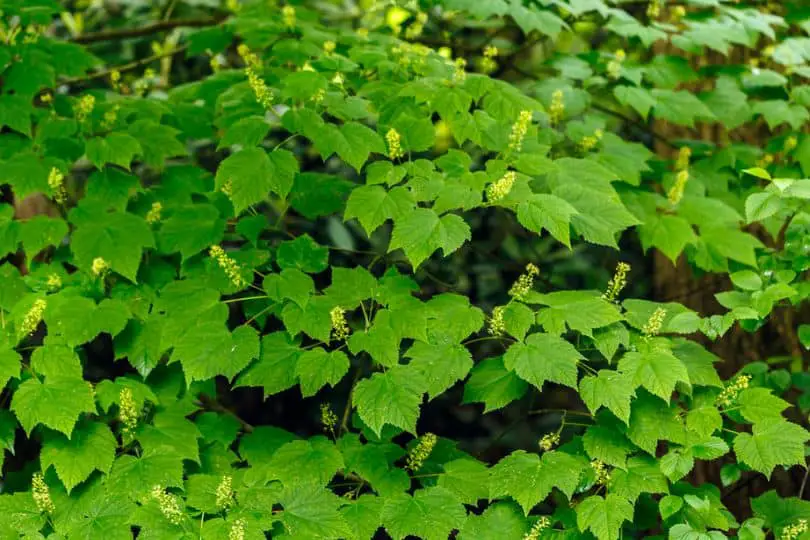
- Common Name: Mountain Maple
- Scientific Name: Acer spicatum
- Mature Height: 20-30 feet
- Native/Non-Native: Native
- Flowers/Cones: Yellowish-green flowers, winged seeds (samara)
- Uses: Not used for commercial purposes
The Mountain Maple is a tiny tree with a single crooked trunk and upright branches that might reach 20-30 feet in height.
It has an uneven crown and lobed, light green leaves that are joined oppositely and have three-pointed lobes and a coarse-toothed border. The leafstalk is frequently red and much longer than the leaf. It has reddish-to-brown bark that is smooth yet grooved with light-colored patches.
Mountain Maples prefer damp soils, streams, and other wet locations, and they enjoy shade. This tree is native to the United States and can be found throughout the country.
It is frequently classified as an understory tree since it grows beneath the canopy of larger, more dominating trees. Because it grows in rocky outcroppings and moose habitats, it is sometimes known as “Moose Maple.”
The Mountain Maple has yellowish-green flowers that grow in spike clusters, as well as winged seeds that are often brilliant red in the spring, turning yellow, then brown in the summer, and finally falling in the early winter.
The seeds measure 34-1″ (2-2.5 cm) and come in pairs. The leaves turn crimson or orange in the fall, making it a beautiful picture.
Although the Mountain Maple has a shallow root system and does not thrive in open areas, it performs an important function in nature by providing food and habitat for a variety of species. Its timber, however, has not been evaluated for commercial usage.
Nonetheless, this tree is important to the ecosystem because it feeds animals and protects streams from erosion. Take a moment to admire Mountain Maple’s beauty and value in nature the next time you see it.
7. Alternate leaf Dogwood
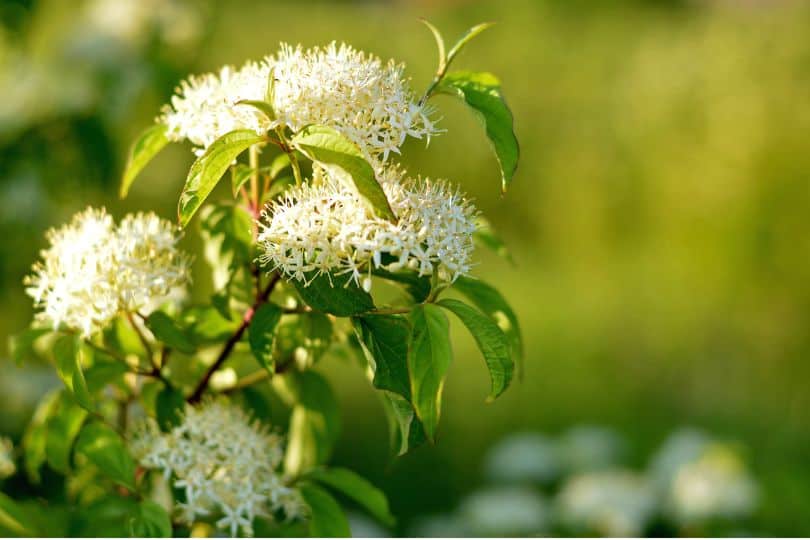
- Common Name: Alternate-leaf Dogwood
- Scientific Name: Cornus alternifolia
- Mature Height: 25-35 feet
- Native/Non-Native: Native
- Flowers/Cones: Small white-to-cream flowers; green berry-like fruits
- Uses: Ornamental tree for landscaping
The Leaf Alternate Dogwood is a tiny tree that can grow to be 35 feet tall, making it ideal for landscaping.
It has a distinct layered appearance, with multi horizontal tiers of branches resembling pagoda levels. This is why it is also known as the Pagoda Dogwood. Its leaves are additionally distinctive in that they are joined alternately, as opposed to other dogwoods, which have oppositely attached leaves.
The Leaf Alternate Dogwood has oval-shaped leaves that are dark green on top and pale on the underside. These leaves range in length from 2 to 5 inches and are frequently found crowded at the terminals of branches.
It blooms in the spring with little white-to-cream flowers in circular clusters 3-5 inches wide. Green berries that mature to be white, blue, or almost black follow these blossoms. The 14-inch-diameter berries have a scarlet fruit stem and are a favorite of birds and other wildlife.
This tree is native to North America and can be found in open forests with good drainage, forest borders, and shade. It is a common sight in woodlands and grows as an understory tree. The leaves turn red in the fall, adding a splash of color to the scene.
8. American Mountain Ash
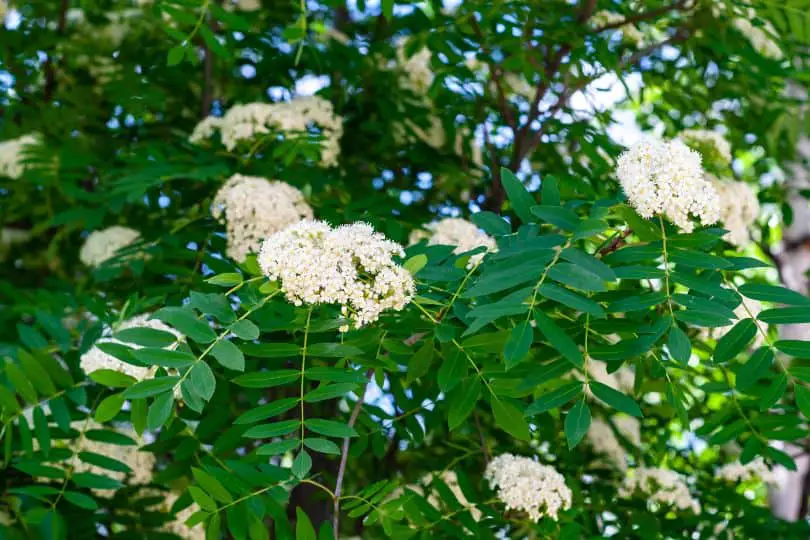
- Common Name: American Mountain Ash
- Scientific Name: Sorbus americana
- Mature Height: 15–30′ (4.5–9 m)
- Native/Non-Native: Native
- Flowers/Cones: Creamish yellow flowers
- Uses: Ornamental planting
With its many stems and spherical crown, American Mountain ash, scientifically known as Sorbus americana, is a tiny tree that frequently seems more like a shrub. It can reach a height of 15-30 feet, making it ideal for modest settings. The leaves are complex and range in length from 6 to 9 inches. Each leaflet has a slightly serrated edge and is 2-4 inches long.
The central stalk (rachis) is frequently reddish, while the leaves are pale green. Light gray bark with elongated horizontal lines. The tree bears lovely white-to-cream blooms that are 14 inches broad and placed in flat clusters that are 3-5 inches wide.
The American Mountain ash is well-known for its beautiful orange or crimson berries that resemble tiny pomes. These 14-inch-diameter fruits grow in 3-5-inch-wide hanging clusters.
They are edible and have a cherry flavor. Birds, particularly Cedar Waxwings and Ruffed Grouse, enjoy them. This tree is frequently planted in gardens to attract birds.
American Mountain-ash is a North American native that thrives in cool, moist environments such as marsh and forest borders, rocky hillsides, and shade. It enjoys places with dappled sunlight or partial shade. It is, however, subject to fire blight disease and sunscald.
9. Russian Olive
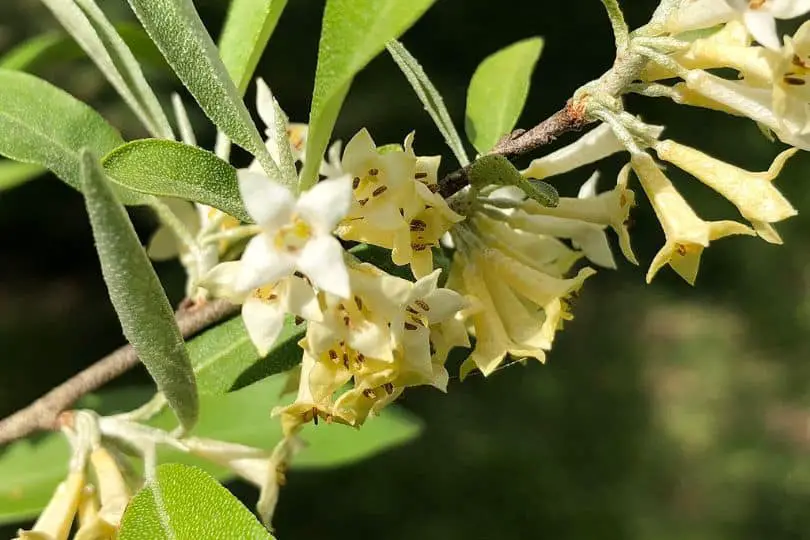
- Common Name: Russian-Olive Tree
- Scientific Name: Elaeagnus angustifolia
- Mature Height: 10-20 feet (3-6 meters)
- Native/Non-Native: Non-native, introduced from Europe
- Flowers/Cones: Yellow flowers and dry olive-like drupe fruits
- Uses: Shelterbelt planting, ornamental planting
The Russian-olive tree is a lovely ornamental shrub that was transported to North America from Europe because of its unique gray foliage and olive-like fruit. The tree can reach a height of 20 feet and has a crooked trunk with an open, uneven crown.
It has simple, lance-shaped leaves that are 1-4 inches long and gray on both sides. The tree’s bark is light gray with shallow furrows, and the twigs frequently have very long thorns that can be salmon-colored on the interior.
The fruit of the Russian olive tree is one of its most intriguing characteristics. The dried gray-to-yellow olive-like drupe fruit has one seed and measures 14-12 inches in diameter.
There is a fleshy layer inside the fruit that is sweet and tasty. This layer protects a hard pit that houses the seed. Birds devour the fruit, which allows the seeds to pass through their digestive processes intact. This aids in the propagation of the tree and allows it to grow naturally in a variety of locations.
The Russian olive tree’s yellow blossoms are equally lovely. They have four petals and are 14 to 12 inches broad. The tree bears fruit in late summer and early autumn. Birds love the fruit, and the tree can be found near historic farmsteads, parks, and in the wild.
Similar Articles
- White Flowering Trees In Ohio
- Common Willow Trees In Ohio
- Common Oak Trees In Ohio
- Common Nut Trees In Ohio
- Common Purple Trees In Ohio
- Native Hickory Trees In Ohio
- Common Pine Trees In Ohio
- Common Birch Trees In Ohio
- Common Ash Trees In Ohio
- Native Cherry Trees In Ohio
- Common Elm Trees In Ohio
- Common Spruce Trees In Ohio
- Common Poplar Trees In Ohio
- Native Plum Trees In Ohio
- Common Maple Trees In Ohio
- Common Cedar Trees In Ohio
- Native Aspen Trees In Ohio
- Common Locust Trees In Ohio
- Common Palm Trees In Ohio
Yellow Flowering Trees In Ohio – Sources
The Regional Gardening team makes sure that the information in our articles is accurate by only using sources that are known to be trustworthy. Some of these sources are peer-reviewed journals from government agencies, well-known universities, and scientific research organizations.
- Trees Of Ohio, Division Of Wildlife
- Trees Of Ohio Field Guide, Book by Stan Tekiela
- Ohio Trees, OSU Extension Publications
- Native Plant Lists, Ohio Department Of Natural Resources
- Ohio Department Of Agriculture
- Gardening, The Ohio State University


